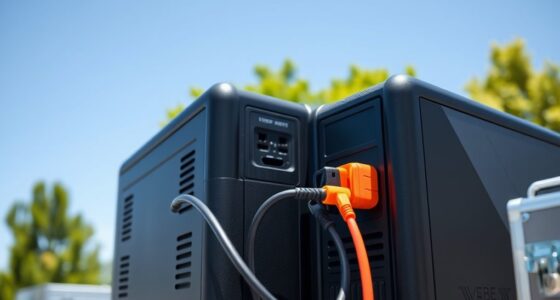Choosing the right extension cord gauge depends on your specific power needs, environment, and cord length. Make sure the insulation protects against moisture and heat, and verify that the cord’s voltage and amperage ratings match your devices. For heavier tasks or outdoor use, opt for thicker gauges like 12- or 10-gauge cords. Keep in mind that longer cords may require a lower gauge to prevent voltage drops. Keep these guidelines in mind, and you’ll be prepared for safe, effective power delivery.
Key Takeaways
- Match cord gauge to the device’s voltage and current requirements to prevent overheating and electrical hazards.
- Use thicker gauges (12 or 10) for outdoor or heavy-duty applications, and thinner gauges (16) for indoor, light-duty tasks.
- Consider the length of the extension cord; longer cords require lower gauges to minimize resistance and voltage drops.
- Ensure the insulation and weatherproofing are suitable for environmental conditions, especially for outdoor use.
- Verify that the cord’s voltage rating exceeds or matches the maximum voltage of connected devices for safe operation.
Extension Cord Gauge Selection Guide

Choosing the right gauge for your extension cord is crucial to guarantee safety and proper performance. The gauge determines how much current the cord can handle, directly impacting your safety and the longevity of your devices. When evaluating options, start by considering the cable insulation, which plays a significant role in protecting against electrical shocks and environmental damage. Quality cable insulation ensures the wire remains safe to touch and resistant to wear, moisture, and heat. This is especially important if you’ll be using the extension cord outdoors or in areas prone to moisture or physical stress. Never compromise on insulation quality, as it’s your first line of defense against electrical hazards.
Next, you need to pay close attention to voltage compatibility. Your extension cord must match or exceed the voltage requirements of your appliances or tools. Using a cord with insufficient voltage capacity can lead to overheating, power failure, or even fires. Always read the voltage specifications printed on your devices and compare them with the cord’s rating. The extension cord’s gauge should support the amperage draw without causing excessive voltage drops, which can damage sensitive equipment or reduce performance. Remember, the thicker the wire (lower gauge number), the higher its current-carrying capacity. For instance, a 14-gauge cord can handle more power than a 16-gauge cord, making it suitable for heavier-duty tasks.
When selecting the gauge, consider the length of your extension cord as well. Longer cords tend to have higher resistance, which can cause voltage drops. To counteract this, opt for a thicker gauge if you’re extending over a significant distance. This ensures your devices receive consistent voltage and prevents performance issues. Always match the gauge to the specific needs of your application, factoring in the power requirements and the length of the run.
Finally, keep in mind that different environments demand different specifications. For indoor use on light-duty appliances, a standard 16-gauge cord might suffice. However, outdoor or heavy-duty applications often require 12-gauge or even 10-gauge cords to handle higher currents safely. By carefully evaluating cable insulation quality and voltage compatibility, you can select the appropriate gauge that offers both safety and peak performance. Making informed choices reduces the risk of electrical failures and prolongs the lifespan of your extension cord and connected devices. Additionally, understanding power capacity helps ensure you choose a cord that can safely handle your equipment’s demands.
Frequently Asked Questions
Can Extension Cords Handle Outdoor Weather Conditions Safely?
Yes, extension cords can handle outdoor weather conditions safely if you choose weatherproofed cords designed for outdoor durability. Look for cords labeled outdoor or weatherproof, which are built to resist moisture, UV rays, and temperature changes. Always follow safety guidelines, such as avoiding water contact and inspecting cords regularly for damage. Proper weatherproofing guarantees safe outdoor use, providing reliable power while protecting you from electrical hazards.
How Does Cord Length Affect Gauge Requirements?
You should know that cord length impacts gauge measurement because longer cords require a thicker gauge to prevent voltage drop and overheating. As the length increases, the gauge number decreases, meaning the wire gets thicker. For example, a 50-foot extension cord may need a 12-gauge wire instead of a 14-gauge to safely handle the same load. Always consider length impact when selecting the right gauge for your extension cord.
Are There Safety Tips for Using High-Gauge Extension Cords?
Imagine you’re using a high-gauge extension cord for indoor safety; always guarantee it’s rated for your device’s power. Avoid daisy-chaining cords, which can cause fire hazards, and keep cords away from water or heat sources. Regularly inspect for damage, and don’t overload the cord beyond its capacity. These safety tips help prevent fire hazards and keep your indoor environment safe when using high-gauge extension cords.
Is It Safe to Run Multiple Devices on One Extension Cord?
Running multiple devices on one extension cord can be safe if you follow power strip safety rules and understand the differences between indoor vs outdoor cords. Always check the cord’s gauge and verify it’s rated for the total current draw. Use a heavy-duty outdoor cord for outdoor devices, and avoid overloading. Keep cords away from water and heat sources, and never daisy-chain multiple extension cords. This keeps your setup safe and reliable.
How Often Should I Replace Old or Damaged Extension Cords?
Think of your extension cord as a trusted bridge that can weaken over time. You should replace old or damaged cords promptly, usually every 3 to 5 years or as soon as you notice signs of cord degradation. Damaged cords compromise electrical safety, increasing the risk of shocks or fires. Regular inspections, especially after heavy use or exposure to elements, guarantee your safety and keep your power flowing smoothly.
Conclusion
Now that you’ve got the essential gauge knowledge, picture yourself effortlessly plugging in your favorite tools or holiday lights, confident that your extension cord can handle the load. With a clear grasp of gauge selection, you’re ready to connect safely and reliably, just like a pro. Think of each cord as a lifeline that keeps your projects powered and your home bright. Keep this checklist in mind, and let your work shine with safety and confidence.









